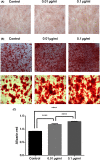Cellular behaviours of bone marrow-derived mesenchymal stem cells towards pristine graphene oxide nanosheets
- PMID: 28771866
- PMCID: PMC6529149
- DOI: 10.1111/cpr.12367
Cellular behaviours of bone marrow-derived mesenchymal stem cells towards pristine graphene oxide nanosheets
Abstract
Objectives: Graphene oxide (GO), the derivative of graphene with unique properties, has attracted much attention for applications in dental implants. The aim of this study was, by two biomimetic cell culture methods, to investigate the quantitative relationship between the concentration of pristine GO nanosheets and their cellular behaviours towards bone marrow-derived mesenchymal stem cells (BMSCs).
Materials and methods: The cells were firstly characterized according to their morphology, self-renewal capabilities and multipotency. Subsequently, adhesion density, proliferation, alkaline phosphatase activity and mineralization of BMSCs treated with various concentrations of GO were analysed. In addition, osteogenic-related proteins were measured for further verification of the GO-induced osteogenic differentiation.
Results: Pristine GO nanosheets inhibited the proliferation of BMSCs at a high concentration of 10 μg/mL during the first 3 days with two seeding methods and facilitated proliferation of BMSCs at a low concentration of 0.1 μg/mL after 5 days with a sequential-seeding method compared to a co-seeding method. Analogously, osteogenic differentiation was promoted when BMSCs were treated with 0.1 μg/mL of GO. Both the proliferation and differentiation showed concentration-dependent behaviour. Interestingly, Wnt/β-catenin signalling pathway appeared to be involved in osteogenic differentiation induced by pristine GO nanosheets.
Conclusions: Pristine GO nanosheets at a concentration of 0.1 μg/mL provide benefits to promote BMSCs proliferation and osteogenesis under a sequential-seeding method, contributing to the use of GO for dental implantation.
© 2017 John Wiley & Sons Ltd.
Conflict of interest statement
There are no competing financial interests among the authors.
Figures







Similar articles
-
Concentration-dependent cellular behavior and osteogenic differentiation effect induced in bone marrow mesenchymal stem cells treated with magnetic graphene oxide.J Biomed Mater Res A. 2020 Jan;108(1):50-60. doi: 10.1002/jbm.a.36791. Epub 2019 Sep 6. J Biomed Mater Res A. 2020. PMID: 31443121
-
Effects of graphene oxide and graphene oxide quantum dots on the osteogenic differentiation of stem cells from human exfoliated deciduous teeth.Artif Cells Nanomed Biotechnol. 2019 Dec;47(1):822-832. doi: 10.1080/21691401.2019.1576706. Artif Cells Nanomed Biotechnol. 2019. PMID: 30873880
-
Low-dose suspended graphene oxide nanosheets induce antioxidant response and osteogenic differentiation of bone marrow-derived mesenchymal stem cells via JNK-dependent FoxO1 activation.J Mater Chem B. 2019 Oct 9;7(39):5998-6009. doi: 10.1039/c9tb01413f. J Mater Chem B. 2019. PMID: 31538158
-
Protein Nanofibril Assemblies Templated by Graphene Oxide Nanosheets Accelerate Early Cell Adhesion and Induce Osteogenic Differentiation of Human Mesenchymal Stem Cells.ACS Appl Mater Interfaces. 2018 Sep 26;10(38):31988-31997. doi: 10.1021/acsami.8b11811. Epub 2018 Sep 11. ACS Appl Mater Interfaces. 2018. PMID: 30204402 Free PMC article.
-
Upregulation of osteogenesis of mesenchymal stem cells with virus-based thin films.Nanotheranostics. 2018 Jan 1;2(1):42-58. doi: 10.7150/ntno.19974. eCollection 2018. Nanotheranostics. 2018. PMID: 29291162 Free PMC article. Review.
Cited by
-
Layer-Number-Dependent Effects of Graphene Oxide on the Pluripotency of Mouse Embryonic Stem Cells Through the Regulation of the Interaction Between the Extracellular Matrix and Integrins.Int J Nanomedicine. 2021 Jun 4;16:3819-3832. doi: 10.2147/IJN.S301892. eCollection 2021. Int J Nanomedicine. 2021. PMID: 34121840 Free PMC article.
-
Graphene and its derivatives: understanding the main chemical and medicinal chemistry roles for biomedical applications.J Nanostructure Chem. 2022;12(5):693-727. doi: 10.1007/s40097-021-00444-3. Epub 2021 Sep 6. J Nanostructure Chem. 2022. PMID: 34512930 Free PMC article. Review.
-
Graphene-Based Nanomaterials for Dental Applications: Principles, Current Advances, and Future Outlook.Front Bioeng Biotechnol. 2022 Mar 10;10:804201. doi: 10.3389/fbioe.2022.804201. eCollection 2022. Front Bioeng Biotechnol. 2022. PMID: 35360406 Free PMC article. Review.
-
Graphene Family Materials in Bone Tissue Regeneration: Perspectives and Challenges.Nanoscale Res Lett. 2018 Sep 18;13(1):289. doi: 10.1186/s11671-018-2694-z. Nanoscale Res Lett. 2018. PMID: 30229504 Free PMC article. Review.
-
[Recent advances in application of graphene oxide for bone tissue engineering].Zhongguo Xiu Fu Chong Jian Wai Ke Za Zhi. 2018 May 15;32(5):625-629. doi: 10.7507/1002-1892.201712063. Zhongguo Xiu Fu Chong Jian Wai Ke Za Zhi. 2018. PMID: 29806354 Free PMC article. Review. Chinese.
References
-
- Novoselov KS, Geim AK, Morozov SV, et al. Electric field effect in atomically thin carbon films. Science. 2004;306:666‐669. - PubMed
-
- Park S, Mohanty N, Suk JW, et al. Biocompatible, robust free‐standing paper composed of a TWEEN/Graphene composite. Adv Mater. 2010;22:1736. - PubMed
-
- Ning L, Xuemin Z, Qin S, et al. The promotion of neurite sprouting and outgrowth of mouse hippocampal cells in culture by graphene substrates. Biomaterials. 2011;32:9374‐9382. - PubMed
-
- La W, Park S, Yoon H, et al. Delivery of a therapeutic protein for bone regeneration from a substrate coated with graphene oxide. Small. 2013;9:4051‐4060. - PubMed
MeSH terms
Substances
LinkOut - more resources
Full Text Sources
Other Literature Sources

